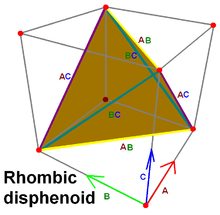- Disphenoid
-
 The tetragonal and digonal disphenoids can be positioned inside a cuboid bisecting two opposite faces. All four faces are isosceles triangles. Both have four equal edges going around the sides. The digonal has two sets of isosceles triangle faces, while the tetragonal form has four identical isosceles triangle faces.
The tetragonal and digonal disphenoids can be positioned inside a cuboid bisecting two opposite faces. All four faces are isosceles triangles. Both have four equal edges going around the sides. The digonal has two sets of isosceles triangle faces, while the tetragonal form has four identical isosceles triangle faces.
 A rhombic disphenoid has 4 identical scalene triangle faces, and can fit diagonally inside of a cuboid. It has three sets of edge lengths, existing as opposite pairs.
A rhombic disphenoid has 4 identical scalene triangle faces, and can fit diagonally inside of a cuboid. It has three sets of edge lengths, existing as opposite pairs.
A disphenoid is a polyhedron whose four faces are identical triangles.[1] The faces of a tetragonal disphenoid are isosceles; the faces of a rhombic disphenoid are scalene. If the faces are equilateral triangles, one obtains a regular tetrahedron, which is not normally considered a disphenoid.
All the solid angles and vertex figures of a disphenoid are the same. However, a disphenoid is not a regular polyhedron, because its faces are not regular polygons.
Some tetragonal disphenoids will form honeycombs. The disphenoid whose four vertices are (-1, 0, 0), (1, 0, 0), (0, 1, 1), and (0, 1, -1) is such a disphenoid.[2] Each of its four faces is an isosceles triangle with edges of lengths √3, √3, and 2. It can tesselate space to form the disphenoid tetrahedral honeycomb. As Gibb[3] describes, it can be folded without cutting or overlaps from a single sheet of a4 paper.
"Disphenoid" is also used to describe two forms of crystal:
- A wedge-shaped crystal form of the tetragonal or orthorhombic system. It has four triangular faces that are alike and that correspond in position to alternate faces of the tetragonal or orthorhombic dipyramid. It is symmetrical about each of three mutually perpendicular diad axes of symmetry in all classes except the tetragonal-disphenoidal, in which the form is generated by an inverse tetrad axis of symmetry.
- A crystal form bounded by eight scalene triangles arranged in pairs, constituting a tetragonal scalenohedron.
See also
- Snub disphenoid - A Johnson solid with 12 equilateral triangle faces and D2d symmetry.
References
- ^ *Coxeter, Regular Polytopes, 3rd. ed., Dover Publications, 1973. ISBN 0-486-61480-8. p. 15
- ^ Coxeter, pp. 71–72; Senechal, Marjorie (1981). "Which tetrahedra fill space?". Mathematics Magazine 54 (5): 227–243. doi:10.2307/2689983. JSTOR 2689983.
- ^ Gibb, William (1990). "Paper patterns: solid shapes from metric paper". Mathematics in School 19 (3): 2–4. Reprinted in Pritchard, Chris, ed. (2003). The Changing Shape of Geometry: Celebrating a Century of Geometry and Geometry Teaching. Cambridge University Press. pp. 363–366. ISBN 0-521-53162-4.
External links
- Weisstein, Eric W., "Disphenoid" from MathWorld.

This geometry-related article is a stub. You can help Wikipedia by expanding it.
